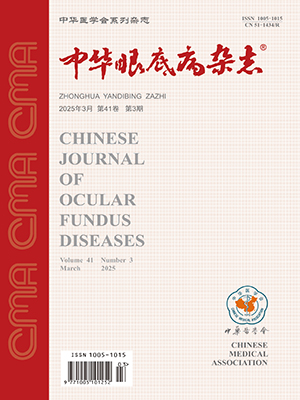| 1. |
雷涛,王润生,吕沛霖,等.缺血性脑血管病患者眼动脉及其主要分支的数字减影血管造影观察[J].中华眼底病杂志,2012,28(5):489-492.DOI:10.3760/cma.j.issn.1005-1015.2012.05.014.Lei T, Wang RS, Lyu PL, et al. Digital subtraction angiography characteristics of ophthalmic artery and its main branches in ischemic cerebrovascular disease[J]. Chin J Ocul Fundus Dis, 2012, 28(5):489-492. DOI:10.3760/cma.j.issn.1005-1015.2012.05.014.
|
| 2. |
王润生,雷涛,王毅,等.超选择性眼动脉及选择性颈内动脉溶栓治疗视网膜中央动脉阻塞的疗效观察[J].中华眼底病杂志,2014,30(5):450-453.DOI:10.3760/cma.j.issn.1005-1015.2014.05.005.Wang RS, Lei T, Wang Y, et al. Super-selective ophthalmic artery or selective carotid artery t hrombolytic therapy for central retinal artery occlusion[J]. Chin J Ocul Fundus Dis, 2014,30(5):450-453.DOI:10.3760/cma.j.issn.1005-1015.2014.05.005.
|
| 3. |
王润生,钱露,王毅,等.眼动脉分支逆行介入溶栓治疗视网膜中央动脉阻塞疗效观察[J].中华眼底病杂志,2016,32(4):377-381.DOI:10.3760/cma.j.issn.1005-1015.2016.04.008.Wang RS, Qian L, Wang Y, et al.Ophthalmic artery branch retrograde interventional therapy for central retinal artery occlusion[J]. Chin J Ocul Fundus Dis, 2016,32(4):377-381.DOI:10.3760/cma.j.issn.1005-1015.2016.04.008.
|
| 4. |
罗树明,汪凯.脑血管病[M]//贾建平.神经病学.北京:人民卫生出版社,2010:182-183.Luo SM, Wang K. Cerebrovascular disease[M]//Jia JP.Neurology. Beijing:People's Medical Publishing House, 2010:182-183.
|
| 5. |
王润生,吕沛霖,张娅萍,等.以尿激酶静脉溶栓为主治疗视网膜中央动脉阻塞115例临床疗效观察[J].中华眼底病杂志,2012,28(5):466-471.DOI:10.3760/cma.j.issn.1005-1015.2012.05.009.Wang RS, Lyu PL, Zhang YP, et al. Intravenous thrombolysis with urokinase for central retinal artery occlusion in 115 patients[J]. Chin J Ocul Fundus Dis, 2012,28(5):466-471. DOI:10.3760/cma.j.issn.1005-1015.2012.05.009.
|
| 6. |
王润生,吕沛霖,王宾,等.视网膜中央动脉阻塞患者视网膜循环时间与中心视力损害的关系[J].中华眼底病杂志,2007,23(3):177-179.Wang RS, Lyu PL, Wang B, et al. Relationship between retinal circulation time and visual loss in patients with central retinal artery occlusion[J]. Chin J Ocul Fundus Dis, 2007,23(3):177-179.
|
| 7. |
潘为领,王学廷,冯丽,等. 256层CTA对颈动脉不同部位闭塞患者侧支循环的评价[J]. 实用放射学杂志,2014,30(9):1458-1461. DOI:10.3969/j.issn.1002-1671.2014.09.009.Pan WL, Wang XT, Feng L, et al. Diagnostic value of 256-slice CT angiography in collateral circulation about carotid artery different segment occlusion[J]. Journal of Practical Radiology, 2014,30(9):1458-1461. DOI:10.3969/j.issn.1002-1671.2014.09.009.
|
| 8. |
Durst CR, Starke RM, Gaughen J, et al. Vision outcomes and major complications after endovascular coil embolization of ophthalmic segment aneurysms[J]. AJNR Am J Neuroradiol, 2014, 35(11):2140-2145. DOI: 10.3174/ajnr.A4032.
|
| 9. |
Rouchaud A, Leclerc O, Benayoun Y, et al. Visual outcomes with flow-diverter stents covering the ophthalmic artery for treatment of internal carotid artery aneurysms[J]. AJNR Am J Neuroradiol, 2015, 36(2):330-336. DOI: 10.3174/ajnr.A4129.
|
| 10. |
王润生, 李官禄, 王为农, 等.眼动脉逆行药物灌注术临床小结[J]. 中国实用眼科杂志, 2000, 18(4):223-224. DOI:10.3760/cma.j.issn.1006-4443.2000.04.012.Wang RS, Li GL, Wang WN, et al. Clinical observation on operation of drugs perfusion retrogracle into ophthalmol artery[J]. Chin J Pract Ophthalmo, 2000, 18(4):223-224. DOI:10.3760/cma.j.issn.1006-4443.2000.04.012.
|
| 11. |
王润生, 李官禄, 王煊, 等.犬眶下动脉终末支逆行插管导药入眼实验研究[J]. 眼科新进展, 2000, 20(4):255-256. DOI:10.3969/j.issn.1003-5141.2000.04.006.Wang RS, Li GL, Wang X, et al.Experimental study of retrograde catheterization and administration of drugs into eyes through the infraorbital arteries in dogs[J]. Rec Adv Ophthalmol, 2000, 20(4):255-256. DOI:10.3969/j.issn.1003-5141.2000.04.006.
|
| 12. |
Ahn JH, Cho YD, Kang HS, et al. Endovascular treatment of ophthalmic artery aneurysms: assessing balloon test occlusion and preservation of vision in coil embolization[J]. AJNR Am J Neuroradiol, 2014, 35(11):2146-2152. DOI: 10.3174/ajnr.A3999.
|
| 13. |
Shaibani A, Khawar S, Bendok B, et al. Temporary balloon occlusion to test adequacy of collateral flow to the retina and tolerance for endovascular aneurysmal coiling[J]. AJNR Am J Neuroradiol, 2004, 25(8):1384-1386.
|
| 14. |
刘华坤,张磊,刘朝来,等.介入分期开通症状性颈内动脉闭塞可行性临床研究[J]. 介入放射学杂志,2016,25(12):1031-1034. DOI:10.3969/j.issn.1008-794X.2016.12.002.Liu HK, Zhang L, Liu ZL, et al. Clinical feasibility study of interventional staged revascularization for symptomatic internal carotid artery occlusion[J]. Journal of Interventional Radiology, 2016, 25(12):1031-1034. DOI:10.3969/j.issn.1008-794X.2016.12.002.
|




